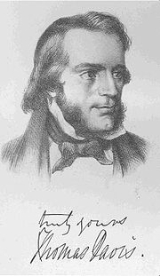
Young Ireland
Encyclopedia
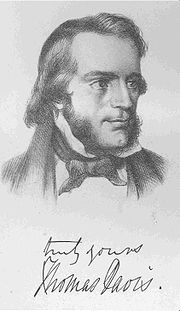
Political movement
A political movement is a social movement in the area of politics. A political movement may be organized around a single issue or set of issues, or around a set of shared concerns of a social group...
, cultural
Cultural movement
A cultural movement is a change in the way a number of different disciplines approach their work. This embodies all art forms, the sciences, and philosophies. Historically, different nations or regions of the world have gone through their own independent sequence of movements in culture, but as...
and social movement
Social movement
Social movements are a type of group action. They are large informal groupings of individuals or organizations focused on specific political or social issues, in other words, on carrying out, resisting or undoing a social change....
of the mid-19th century. It led changes in Irish nationalism
Irish nationalism
Irish nationalism manifests itself in political and social movements and in sentiment inspired by a love for Irish culture, language and history, and as a sense of pride in Ireland and in the Irish people...
, including an abortive rebellion known as the Young Irelander Rebellion of 1848
Young Irelander Rebellion of 1848
The Young Irelander Rebellion was a failed Irish nationalist uprising led by the Young Ireland movement. It took place on 29 July 1848 in the village of Ballingarry, County Tipperary. After being chased by a force of Young Irelanders and their supporters, an Irish Constabulary unit raided a house...
. Many of the latter's leaders were tried for sedition
Sedition
In law, sedition is overt conduct, such as speech and organization, that is deemed by the legal authority to tend toward insurrection against the established order. Sedition often includes subversion of a constitution and incitement of discontent to lawful authority. Sedition may include any...
and sentenced to penal transportation
Penal transportation
Transportation or penal transportation is the deporting of convicted criminals to a penal colony. Examples include transportation by France to Devil's Island and by the UK to its colonies in the Americas, from the 1610s through the American Revolution in the 1770s, and then to Australia between...
to Van Diemen's Land
Van Diemen's Land
Van Diemen's Land was the original name used by most Europeans for the island of Tasmania, now part of Australia. The Dutch explorer Abel Tasman was the first European to land on the shores of Tasmania...
. From its beginnings in the late 1830s, Young Ireland grew in influence and inspired following generations of Irish nationalists.
History
.jpg)
Repeal Association
The Repeal Association was an Irish mass membership political movement set up by Daniel O'Connell to campaign for a repeal of the Act of Union of 1800 between Great Britain and Ireland....
members who were associated with The Nation
The Nation (Irish newspaper)
The Nation was an Irish nationalist weekly newspaper, published in the 19th century. The Nation was printed first at 12 Trinity Street, Dublin, on 15 October 1842, until 6 January 1844...
newspaper. At the time, the Repeal Association
Repeal Association
The Repeal Association was an Irish mass membership political movement set up by Daniel O'Connell to campaign for a repeal of the Act of Union of 1800 between Great Britain and Ireland....
was campaigning for the repeal of the Act of Union 1800
Act of Union 1800
The Acts of Union 1800 describe two complementary Acts, namely:* the Union with Ireland Act 1800 , an Act of the Parliament of Great Britain, and...
between the kingdoms of Great Britain
Great Britain
Great Britain or Britain is an island situated to the northwest of Continental Europe. It is the ninth largest island in the world, and the largest European island, as well as the largest of the British Isles...
and Ireland. The term was first coined by the "English" press, and later used by leader Daniel O'Connell
Daniel O'Connell
Daniel O'Connell Daniel O'Connell Daniel O'Connell (6 August 1775 – 15 May 1847; often referred to as The Liberator, or The Emancipator, was an Irish political leader in the first half of the 19th century...
in a vindictive attack at Conciliation Hall, home of the Repeal Association
Repeal Association
The Repeal Association was an Irish mass membership political movement set up by Daniel O'Connell to campaign for a repeal of the Act of Union of 1800 between Great Britain and Ireland....
.
Young Ireland traced its origins to the new College Historical Society, founded on 29 March 1839, at a meeting at Francis Kearney’s chambers, 27 College. Among the members of this new society were John Blake Dillon
John Blake Dillon
John Blake Dillon was an Irish writer and Politician who was one of the founding members of the Young Ireland movement....
, Thomas MacNevin, William Eliot Hudson and Thomas Davis
Thomas Osborne Davis (Irish politician)
Thomas Osborne Davis was a revolutionary Irish writer who was the chief organizer and poet of the Young Ireland movement.-Early life:...
, who was elected its president in 1840. While still at Trinity College
Trinity College, Dublin
Trinity College, Dublin , formally known as the College of the Holy and Undivided Trinity of Queen Elizabeth near Dublin, was founded in 1592 by letters patent from Queen Elizabeth I as the "mother of a university", Extracts from Letters Patent of Elizabeth I, 1592: "...we...found and...
, Davis had addressed the Dublin Historical Society, which met at the Dorset Institute in Upper Sackville Street from 1836 to 1838. Davis became president and gave two lectures. (Available from the National Library of Ireland, the lectures clearly show that Davis had become a convinced Irish nationalist by this period.
Repeal Association
On 15 April 1840, Daniel O’Connell held the first meeting of his new Repeal AssociationRepeal Association
The Repeal Association was an Irish mass membership political movement set up by Daniel O'Connell to campaign for a repeal of the Act of Union of 1800 between Great Britain and Ireland....
, in the Corn Exchange
Corn exchange
A corn exchange or grain exchange was a building where farmers and merchants traded cereal grains. Such trade was common in towns and cities across Great Britain and Ireland until the 19th century, but as the trade became centralised in the 20th century many such buildings were used for other...
, Dublin. The group was received with sneers, and O’Connell’s sincerity was questioned. In the General Election in 1832, O’Connell had made the same appeal for repeal. Although half the representatives chosen for Ireland were pledged Repealers, O’Connell dropped the demand. Several new members accepted appointments under the system they had pledged to overthrow. Since that time, O’Connell had become a close ally of the Whigs
British Whig Party
The Whigs were a party in the Parliament of England, Parliament of Great Britain, and Parliament of the United Kingdom, who contested power with the rival Tories from the 1680s to the 1850s. The Whigs' origin lay in constitutional monarchism and opposition to absolute rule...
. As they were expected to fall from power in 1840, activists' renewing the agitation for Repeal was suspected as a devise to embarrass the new administration. Not one man of status, outside the members of the defunct Association, joined the ranks of the new one. With the new Association's mounting debts, the contributions from its members not sufficient to pay half its ordinary expenses, both Thomas Davis
Thomas Osborne Davis (Irish politician)
Thomas Osborne Davis was a revolutionary Irish writer who was the chief organizer and poet of the Young Ireland movement.-Early life:...
and John Blake Dillon
John Blake Dillon
John Blake Dillon was an Irish writer and Politician who was one of the founding members of the Young Ireland movement....
, joined its ranks in April 1841, having in the process, to overcome their dislike of the abusive tone of O’Connell’s agitation. O’Connell welcomed them and made them members of the General Committee, which controlled the organisation of the Association. The two men began their work in earnest; Davis first became Chairman of a sub-committee in charge of the registers of the Association, which contained the names of all the Members.
Davis thus could communicate with all the leading politicians of the Party, and whenever he came across any with depth or ability; he at once developed into friendly associations. In the autumn of 1841, Dillon and Davis took over the roles of Editor and sub-Editor of the Morning Register, a Dublin daily paper belonging to Alderman Staunton, which had been the organ of the Catholic Association
Catholic Association
The Catholic Association was an Irish Roman Catholic political organisation set up by Daniel O'Connell in the early nineteenth century to campaign for Catholic emancipation within the United Kingdom of Great Britain and Ireland. It was one of the first mass-membership political movements in...
, and “was generally regarded among the mercenaries” of the Dublin Castle, according to Michael Doheny
Michael Doheny
Michael Doheny was an Irish writer and member of the Young Ireland movement.-Early life:The third son of Michael Doheny, of Brookhill, he was born at Brookhill, near Fethard, Co. Tipperary, and married a Miss O'Dwyer of that county...
, who was to become one of Young Ireland's leading figures. As editors they featured articles on such topics as Protestant nationality, historical parallels from classic and mediaeval history, and agencies and conditions of guerrilla warfare. Michael Doheny
Michael Doheny
Michael Doheny was an Irish writer and member of the Young Ireland movement.-Early life:The third son of Michael Doheny, of Brookhill, he was born at Brookhill, near Fethard, Co. Tipperary, and married a Miss O'Dwyer of that county...
suggests in his Felon’s Track that “all Dublin was startled by the originality, vigour and brilliancy of its articles”. It was also at this time that they first came into contact with Charles Gavan Duffy
Charles Gavan Duffy
Additional Reading*, Allen & Unwin, 1973.*John Mitchel, A Cause Too Many, Aidan Hegarty, Camlane Press.*Thomas Davis, The Thinker and Teacher, Arthur Griffith, M.H. Gill & Son 1922....
. On Duffy’s next visit to Dublin some six months later, he discovered that Davis and Dillon had abandoned their experiment with the Register. Davis had no way to reach a wider public, even with his contributions to the Dublin Monthly Magazine.
The Nation
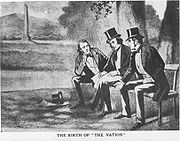
The Nation (Irish newspaper)
The Nation was an Irish nationalist weekly newspaper, published in the 19th century. The Nation was printed first at 12 Trinity Street, Dublin, on 15 October 1842, until 6 January 1844...
. Into this new venture, Dillon brought two young friends, the barrister John O'Hagan
John O'Hagan
John O'Hagan was an Irish lawyer and writer.-Life:He was educated in the day-school of the Jesuit Fathers, Dublin, and in Trinity College, Dublin, graduating in 1842...
and law student John Edward Pigot
John Edward Pigot
John Edward Pigot was an Irish music collector.Pigot was born in Kilworth, Co. Cork and became friendly with Thomas Davis of the Young Ireland movement. They published advertisements in The Nation asking those who had Irish tunes to send them in. This started the Pigot Collection. He studied...
. Davis brought some of his circle of young friends from the Historical Society, and Duffy brought in the poet James Clarence Mangan
James Clarence Mangan
James Clarence Mangan, born James Mangan was an Irish poet.-Early life:Mangan was the son of a former hedge school teacher who took over a grocery business and eventually became bankrupt....
; William O’Neill Daunt, a County Cork landowner; and T. M. Hughes, former editor of the London Charivari , which was later absorbed into Punch
Punch (magazine)
Punch, or the London Charivari was a British weekly magazine of humour and satire established in 1841 by Henry Mayhew and engraver Ebenezer Landells. Historically, it was most influential in the 1840s and 50s, when it helped to coin the term "cartoon" in its modern sense as a humorous illustration...
. On 15 October 1842, the first number of The Nation was launched. “The appearance of The Nation and its immediate and phenomenal success was a reinforcement for which O’Connell had scarcely dared to hope”.
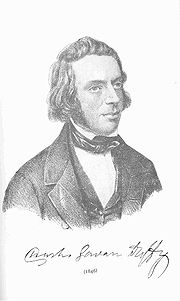
The Secession
.jpg)
Irish Confederation
The Irish Confederation was an Irish nationalist independence movement, established on 13 January 1847 by members of the Young Ireland movement who had seceded from Daniel O'Connell's Repeal Association. Historian T. W...
”.
O'Connell had used the threat of force, as was seen in his campaign for Catholic Emancipation
Catholic Emancipation
Catholic emancipation or Catholic relief was a process in Great Britain and Ireland in the late 18th century and early 19th century which involved reducing and removing many of the restrictions on Roman Catholics which had been introduced by the Act of Uniformity, the Test Acts and the penal laws...
, but afterward he did not have the will. This was demonstrated by the cancelled 'monster meeting' planned for Clontarf
Clontarf, Dublin
Clontarf is a coastal suburb on the northside of Dublin, in Ireland. It is most famous for giving the name to the Battle of Clontarf in 1014, in which Brian Boru, High King of Ireland, defeated the Vikings of Dublin and their allies, the Irish of Leinster. This battle, which extended to districts...
in 1843. The monster Meetings were long a design of Thomas Davis
Thomas Osborne Davis (Irish politician)
Thomas Osborne Davis was a revolutionary Irish writer who was the chief organizer and poet of the Young Ireland movement.-Early life:...
, John Blake Dillon
John Blake Dillon
John Blake Dillon was an Irish writer and Politician who was one of the founding members of the Young Ireland movement....
and Michael Doheny
Michael Doheny
Michael Doheny was an Irish writer and member of the Young Ireland movement.-Early life:The third son of Michael Doheny, of Brookhill, he was born at Brookhill, near Fethard, Co. Tipperary, and married a Miss O'Dwyer of that county...
. The object of which was to train the people to military movements, since this object would obviously be unsafe to announce, it was to be effected by other means. Daniel O’Connell was fully aware of their intent at the time, though he later denied it and repudiated those involved. This meeting was prohibited by the British government, backed up with the threat of military force. O'Connell took a political decision to not press ahead with the summoning of the planned meeting for Clontarf, as the government had plans ready to suppress it. This diminished his credibility with the British - they were only prepared to concede when they believed that there was a serious risk of an uprising. The Young Irelanders had always agreed with Daniel O'Connell
Daniel O'Connell
Daniel O'Connell Daniel O'Connell Daniel O'Connell (6 August 1775 – 15 May 1847; often referred to as The Liberator, or The Emancipator, was an Irish political leader in the first half of the 19th century...
and the Repeal Association
Repeal Association
The Repeal Association was an Irish mass membership political movement set up by Daniel O'Connell to campaign for a repeal of the Act of Union of 1800 between Great Britain and Ireland....
in its demand for repeal, but split, when it did come, was over O'Connell's attempts to form an alliance with the Whig Party
British Whig Party
The Whigs were a party in the Parliament of England, Parliament of Great Britain, and Parliament of the United Kingdom, who contested power with the rival Tories from the 1680s to the 1850s. The Whigs' origin lay in constitutional monarchism and opposition to absolute rule...
in England, which would have led to the dropping of repeal, as had happened in 1835. While the pretence used by O’Connell’s supporters, was the adoption of the Peace Resolutions.
The Irish Confederation
.jpg)
The success of the meeting suggested the possibility of an experiment upon a large scale, as a preliminary to the formation of the Confederation. The meeting was set for the 2 December. The main object was to reply to the calumnies which, for nearly six months, had been urged against the leading seceders. The remonstrant committee offered to defend them against any allegations put by the Repeal Association. The meeting was one of the most important ever held in the city. The entire ability of the seceders was put into its preparation. Michael Doheny states that “such was the sensation created by the proceedings that two publishers, one in Dublin and one in Belfast, brought out reports, in pamphlet form, which were read all over the country with the greatest avidity”. It was suggested, casually at the meeting, that the seceders would meet in January to announce the course of political action they would recommend. On 13 January, the seceders met again, and their deliberations were supported again by the same men, to secure to the seceders freedom of speech and of action. It was at this meeting the Irish Confederation
Irish Confederation
The Irish Confederation was an Irish nationalist independence movement, established on 13 January 1847 by members of the Young Ireland movement who had seceded from Daniel O'Connell's Repeal Association. Historian T. W...
was fully established. The foundations of which were to be freedom, tolerance and truth. There were no declarations or calls for rebellion, and no pledges of peace were given. The objectives were they outlined the independence of the Irish nation and no means to attain that end were abjured, save such as were inconsistent with honour, morality and reason.
1848 Uprising

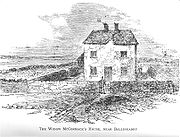
French Revolution
The French Revolution , sometimes distinguished as the 'Great French Revolution' , was a period of radical social and political upheaval in France and Europe. The absolute monarchy that had ruled France for centuries collapsed in three years...
, and popular uprisings in 1848 across Europe in which governments and monarchies toppled in favor of democratic reforms.
William Smith O'Brien
William Smith O'Brien
William Smith O'Brien was an Irish Nationalist and Member of Parliament and leader of the Young Ireland movement. He was convicted of sedition for his part in the Young Irelander Rebellion of 1848, but his sentence of death was commuted to deportation to Van Diemen's Land. In 1854, he was...
, the leader of the Young Ireland Party, launched an attempted rebellion in July 1848, in response to British repression and the introduction of martial law. He gathered landlords and tenants together with Young Irelanders. O'Brien's failure to capture a party of police barricaded in widow McCormack's house, who were holding her children as hostages, marked the effective end of the revolt.”, Though intermittent resistance continued till late 1849, O'Brien and his colleagues were quickly arrested and convicted of sedition. Originally sentenced to death, the young men received a great outpouring of public support. The government commuted their sentences to penal transportation
Penal transportation
Transportation or penal transportation is the deporting of convicted criminals to a penal colony. Examples include transportation by France to Devil's Island and by the UK to its colonies in the Americas, from the 1610s through the American Revolution in the 1770s, and then to Australia between...
to Van Diemen's Land
Van Diemen's Land
Van Diemen's Land was the original name used by most Europeans for the island of Tasmania, now part of Australia. The Dutch explorer Abel Tasman was the first European to land on the shores of Tasmania...
, where they joined John Mitchel
John Mitchel
John Mitchel was an Irish nationalist activist, solicitor and political journalist. Born in Camnish, near Dungiven, County Londonderry, Ireland he became a leading member of both Young Ireland and the Irish Confederation...
. The "Irish gentlemen" were assigned to different settlements to try to reduce their continued collaboration.
Young Irelanders
- Thomas DavisThomas Osborne Davis (Irish politician)Thomas Osborne Davis was a revolutionary Irish writer who was the chief organizer and poet of the Young Ireland movement.-Early life:...
- John Blake DillonJohn Blake DillonJohn Blake Dillon was an Irish writer and Politician who was one of the founding members of the Young Ireland movement....
- Kevin Izod O'DohertyKevin Izod O'DohertyKevin Izod O'Doherty was an Irish Australian politician.-Biography:O'Doherty was born in Dublin on 7 September 1823, although other sources indicate that he may have been born in June 1824 and Charles Gavan Duffy, in his My Life in Two Hemispheres, states that O'Doherty was still under age when he...
- Michael DohenyMichael DohenyMichael Doheny was an Irish writer and member of the Young Ireland movement.-Early life:The third son of Michael Doheny, of Brookhill, he was born at Brookhill, near Fethard, Co. Tipperary, and married a Miss O'Dwyer of that county...
- John MitchelJohn MitchelJohn Mitchel was an Irish nationalist activist, solicitor and political journalist. Born in Camnish, near Dungiven, County Londonderry, Ireland he became a leading member of both Young Ireland and the Irish Confederation...
- Charles Gavan DuffyCharles Gavan DuffyAdditional Reading*, Allen & Unwin, 1973.*John Mitchel, A Cause Too Many, Aidan Hegarty, Camlane Press.*Thomas Davis, The Thinker and Teacher, Arthur Griffith, M.H. Gill & Son 1922....
- Patrick O'Donoghue
- James Fintan LalorJames Fintan LalorJames Fintan Lalor was an Irish revolutionary, journalist, and “one of the most powerful writers of his day.” A leading member of the Irish Confederation , he was to play an active part in both the Rebellion in July 1848 and the attempted Rising in September of that same year...
- Terence MacManusTerence MacManusTerence Bellew MacManus was a radical Irish rebel who participated in the Young Irelander Rebellion of 1848. Sentenced to death for treason, he and several other participants were given commuted sentences in 1849 and transported for life to Van Diemen's Land in Australia...
- John MartinJohn Martin (Ireland)John Martin was an Irish nationalist activist who progressed from early militant support for Young Ireland and Repeal, to non-violent alternatives such as support for tenant farmers' rights and eventually as the first Home Rule MP, for Meath 1871-1875...
- Thomas Francis MeagherThomas Francis Meagher-Young Ireland:Meagher returned to Ireland in 1843, with undecided plans for a career in the Austrian army, a tradition among a number of Irish families. In 1844 he traveled to Dublin with the intention of studying for the bar. He became involved in the Repeal Association, which worked for repeal...
- Thomas Devin ReillyThomas Devin ReillyThomas Devin Reilly was an Irish revolutionary, Young Irelander and journalist.-Early years:He was born in Monaghan Town, the son of a solicitor, and completed his education at Trinity College, Dublin...
- John Edward PigotJohn Edward PigotJohn Edward Pigot was an Irish music collector.Pigot was born in Kilworth, Co. Cork and became friendly with Thomas Davis of the Young Ireland movement. They published advertisements in The Nation asking those who had Irish tunes to send them in. This started the Pigot Collection. He studied...
- Thomas MacNevinThomas MacNevinThomas MacNevin was an influential Irish writer and journalist, who died under “peculiarly sad circumstances” in a Bristol asylum. According to T. F...
- Thomas D'Arcy McGee
See also
- Famine Rebellion of 1848
- History of Ireland (1801-1922)
- Irish Potato Famine (1845-1849)
Other groups with the name
- Young Ireland: Buy IrishYoung Ireland: Buy IrishYoung Ireland: Buy Irish Campaign was a group active in second level schools and some colleges in the 1980's. It was originally founded in 1983 by Denis Craven, a teacher at Oatlands College, Stillorgan, County Dublin....
- Many GAAGaelic Athletic AssociationThe Gaelic Athletic Association is an amateur Irish and international cultural and sporting organisation focused primarily on promoting Gaelic games, which include the traditional Irish sports of hurling, camogie, Gaelic football, handball and rounders...
clubs are named "Éire ÓgÉire ÓgÉire Óg may refer to:*Young Ireland, an Irish political movement from 1839 to 1849* Éire Óg, an Irish rebel music group from the early 1990s.* Eire Og/Corrachoill GAA, a Gaelic Athletic Association club in Kildare...
".
Further reading
- Malcolm Brown, The Politics of Irish Literature: from Thomas Davis to W.B. Yeats, Allen & Unwin, 1973.
- Aidan Hegarty, John Mitchel, A Cause Too Many, Camlane Press.
- Arthur Griffith, Thomas Davis, The Thinker and Teacher, M.H. Gill & Son, 1922.
- Brigadier-General Thomas Francis Meagher His Political and Military Career, Capt. W. F. Lyons, Burns Oates & Washbourne Limited, 1869
- Young Ireland and 1848, Dennis Gwynn, Cork University Press, 1949.
- Daniel O'Connell The Irish Liberator, Dennis Gwynn, Hutchinson & Co, Ltd.
- O'Connell Davis and the Collages Bill, Dennis Gwynn, Cork University Press, 1948.
- Smith O’Brien And The “Secession”, Dennis Gwynn, Cork University Press
- Meagher of The Sword, Edited By Arthur Griffith, M. H. Gill & Son, Ltd., 1916.
- Young Irelander Abroad: The Diary of Charles Hart, Ed. Brendan O'Cathaoir, University Press.
- John Mitchel: First Felon for Ireland, Ed. Brian O'Higgins, Brian O'Higgins 1947.
- Rossa's Recollections: 1838 to 1898, The Lyons Press, 2004.
- James Connolly, Labour in Ireland, Fleet Street, 1910.
- James Connolly, The Re-Conquest of Ireland, Fleet Street, 1915.
- Louis J. Walsh, John Mitchel: Noted Irish Lives, The Talbot Press Ltd, 1934.
- Life of John Mitchel, P. A. Sillard, James Duffy and Co., Ltd 1908.
- John Mitchel, P. S. O'Hegarty, Maunsel & Company, Ltd 1917.
- R. V. Comerford, The Fenians in Context: Irish Politics & Society 1848-82, Wolfhound Press, 1998
- Seamus MacCall, Irish Mitchel, Thomas Nelson and Sons Ltd, 1938.
- T. A. Jackson, Ireland Her Own, Lawrence & Wishart, Ltd, 1976.
- T. C. Luby, Life and Times of Daniel O'Connell, Cameron & Ferguson.
- T. F. O'Sullivan, Young Ireland, The Kerryman Ltd., 1945.
- Terry Golway, Irish Rebel John Devoy and America's Fight for Irish Freedom, St. Martin's Griffin, 1998.
- Thomas Gallagher, Paddy's Lament: Ireland 1846-1847 Prelude to Hatred, Poolbeg, 1994.
- James Fintan Lalor, Thomas, P. O'Neill, Golden Publications, 2003.
- Charles Gavan Duffy: Conversations With Carlyle (1892), with Introduction, Stray Thoughts On Young Ireland, by Brendan Clifford, Athol Books, Belfast, ISBN 0 85034 1140.
- Brendan Clifford and Julianne Herlihy, Envoi, Taking Leave Of Roy Foster, Cork: Aubane Historical Society
- Robert Sloan, William Smith O'Brien and the Young Ireland Rebellion of 1848, Four Courts Press, 2000
- An Gorta Mor), M. W. Savage, The Falcon Family, or, Young Ireland, London: 1845, Quinnipiac University
External links
- Young Ireland from the Encyclopedia of 1848 Revolutions
- An Gorta Mor from Quinnipiac University
- Legal transcripts relating to the trials of Young Irelanders.
- Young Irelanders in Tasmania
- Young Irelanders in Tasmania wiki

